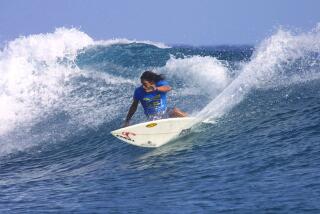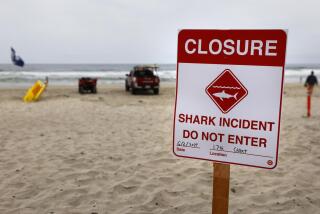Maui shark attack victim loses an arm; 11 precautions you can take
A Maui shark attack victim was in critical condition Thursday after her right arm was bitten off as she snorkeled off a beach on the southern part of the island.
German tourist Jana Witteropp, 20, was snorkeling off Maui’s Palauea Beach when she was apparently attacked by a shark. Her right arm was severed at the shoulder, according to local media. Another tourist, California high school teacher Rick Moore, swam to her and brought her to shore, reports Hawaii News Now.
Moore said a police officer applied a tourniquet, but Witteropp was “fading away.” He performed CPR before the woman was transported to Maui Memorial Hospital. Calls by the Los Angeles Times to the hospital on Friday were not returned.
Beaches surrounding Palauea Beach on Maui, near the site of the attack, were temporarily closed following the incident but by Friday morning had reopened. This year, there have been eight reported shark attacks in Hawaii, with five of those off Maui, according to the Honolulu Star-Advertiser. In 2012, Hawaii had a 12-year peak of 11 shark attacks.
Frightening stuff, but tourists should keep in mind that the risk of sharks attacking humans remains low.
As Chris Lowe, a professor at Cal State Long Beach and head of the university’s Sharklab, told the Los Angeles Times: “It’s far more dangerous driving to the beach than swimming in the ocean.”
Lowe noted that scientists and researchers really do not know for certain what motivates a shark to bite a human. It could be simply that the shark is hungry or that it feels threatened. But you can take some common-sense precautions.
“People need to be smart about how they go into the ocean,” Lowe said, especially when visiting a place they’re unfamiliar with. ... This is not Disneyland. You have to do your homework.”
Familiarize yourself with potential dangers when visiting an unfamiliar beach -- not just sharks but riptides and other possible dangers. Lowe recommends going online and doing some research and also talking to the local lifeguards before you dive in.
Here are 10 other recommendations from the Hawaii Division of Aquatic Resources to minimize your risk of shark attack.
-- Swim, surf or dive with other people, and don’t move too far away from assistance.
-- Avoid going into the water at the hours when sharks come closer to shore to feed. Some species move inshore at dawn, dusk and at night.
-- Are you bleeding in any way? Don’t go in. Sharks can sense blood and body fluids, even in very small amounts.
-- Sharks tend to frequent murky waters, harbor entrances and stream mouths. Avoid those places.
-- High-contrast clothing and shiny jewelry are best avoided.
-- Don’t splash around. Sharks have been known to be attracted to excessive splashing, and pets are best kept out of water because they swim erratically.
-- If a shark has been sighted, leave the water quickly but calmly. And don’t harass any shark, even the little ones.
-- Pay attention to how fish and turtles are behaving. If they act erratically, a shark may be in the vicinity. And don’t swim near dolphins; they are prey for some large sharks.
-- Don’t swim near people who are fishing or spear fishing.
-- Go to the beaches that are patrolled by lifeguards and follow their advice.
More to Read
Sign up for The Wild
We’ll help you find the best places to hike, bike and run, as well as the perfect silent spots for meditation and yoga.
You may occasionally receive promotional content from the Los Angeles Times.







